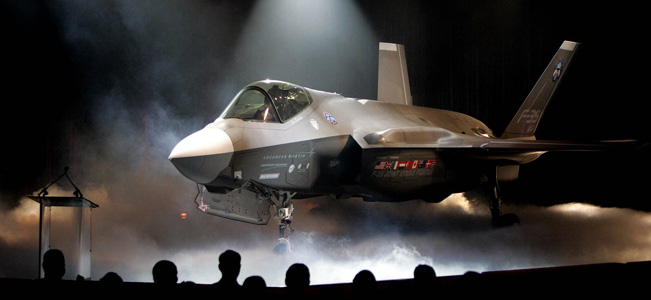 |
AP/Matthew Ottero, file The Lockheed Martin Joint Strike Fighter was unveiled in a ceremony in Fort Worth, Texas, in 2006 |
WASHINGTON (AFP) – The F-35 fighter jet, set to replace a large part of the US warplane fleet, has become the most expensive weapons program ever, drawing increased scrutiny at a time of tight public finances.
Following a series of cost overruns and delays, the program is now expected to cost a whopping 382 billion dollars, for 2,443 aircraft.The so-called 5th generation fighter was built with features designed to help avoid enemy radar and ensure American supremacy in the skies for decades.But there is now the potential for competition from China, which this week unveiled its first radar-evading combat aircraft and fueled a sense of a military rivalry between the two powers.
At home, the Lockheed Martin F-35 is getting increased criticism even from some at the Pentagon.
Defense officials say the original cost estimates have now doubled to make each plane's price tag reach some 92 million dollars.
At the same time, the contract awarded in 2001 had been planned to last 10 years, but has been extended to 2016 because of testing and design issues.
Lockheed Martin, which is working with Northrop Grumman and BAE Systems, is developing three versions of the aircraft, which are being designed for ground attack as well as reconnaissance missions.
The F-35A is designed to replace the F-16 and A-10 of the US Air Force, while the F-35C is designed for deployment on aircraft carriers to supplant to F-18, and the F-35B would have a vertical takeoff capacity and replace Harrier aircraft.
US Defense Secretary Robert Gates has warned the cost overruns cannot continue and expressed particular concern over the short take-off and vertical landing variant.
"The culture of endless money that has taken hold must be replaced by a culture of restraint," he said recently
For the short-takeoff version, Gates has ordered "the equivalent of a two-year probation," adding that "if we cannot fix this variant during this time frame and get it back on track in terms of performance, cost and schedule, then I believe it should be canceled."
As part of a cost-saving drive, the Pentagon chief has decided to delay the purchase of 124 of the 449 units of this version until 2016.
Another bone of contention is a second engine being developed for the fighter by General Electric and Rolls Royce in case the Pratt & Whitney engine is not up to par. Gates contends this second engine is "unneeded."
Private analysts say the whole F-35 program is becoming a money pit.
"The incredibly unfortunate phrase 'too big to fail' applies to this aircraft more than any other defense program," said Richard Aboulafia, an aerospace industry analyst with the Teal Group.
"It's difficult to think of a civil or military program in the past decade that hasn't experienced similar delays and cost overruns."
Still, it may be hard to make many changes to the F-35 program because Britain and seven other countries have been closely involved in its development.
The United States is covering 90 percent of the cost of the development but has participation from Britain, Italy, Turkey, the Netherlands, Canada, Denmark, Norway and Australia.
Other nations, including Israel and Singapore, have signed contracts to buy the plane.
"The US wants a globalized JSF program for a combination of strategic and economic reasons," said Aboulafia.
"It greatly simplifies logistics, training and doctrine for coalition warfighting. Dominating the military aerospace export business is certainly a strong draw, too. It's as much an industrial policy as a fighter."
news sourse Yahoo! News full story here

No comments:
Post a Comment